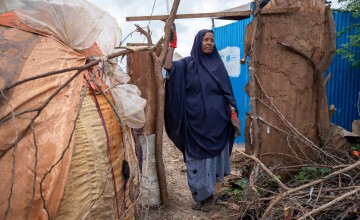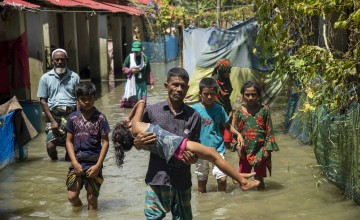
Read our 2023 annual report

Knowledge Hub
Over half of all internal displacements last year were due to climate change. Here’s what you need to know about “the refugees the world barely pays attention to.”
For many refugees, climate change is a reality of displacement, a factor that makes their survival that much harder-won. Rohingya refugees in climate-affected Bangladesh face the impacts of the crisis on the country, especially in increasingly severe monsoon seasons that flood camps and destroy temporary homes. The effects of climate change in Lebanon, from water stress to harsh winters, mean that over 750,000 Syrian refugees suffer biting cold spells and struggle to get clean and safe water on a regular basis.
However, climate change is not only a challenge faced by refugees. It’s also a leading cause of forced displacement, and one that we often ignore. They’ve been called “environmental refugees,” “the world’s forgotten victims,” and “the refugees the world barely pays attention to.” Here’s what you need to know about climate refugees.

Climate displacement, explained
Climate change is expected to be a key driver of migration and displacement in the coming decades. Now, more than any time in recorded history, people are forced to flee their homes to cope with extreme weather events; either for short-term evacuations lasting hours or days, or longer and even protracted displacement.
Shifting rainfall patterns, spreading desertification and falling agricultural productivity are likely to undermine rural livelihoods, worsen job prospects in rural areas, and accelerate the migration to urban areas. This exposes people to different risks, many that they are less able to cope with. However, mobility is also a positive coping strategy that helps people preserve their own well-being in response to both slow- and sudden-onset disasters.
Climate refugees are technically not refugees
The UN’s definition of a refugee is someone who has crossed an international border due to a “well-founded fear of being persecuted for reasons of race, religion, nationality, membership of a particular social group or political opinion” or conflicts and “events seriously disturbing public order.” However, climate change and conflict often go hand-in-hand, leaving many people claiming refugee status doing so because these two elements have intersected.
The United Nations High Commissioner for Refugees argues that “climate refugee” is inaccurate based on this definition. Many people fleeing the effects of climate change do not leave their own country and, based on climate events alone, generally do not face persecution. “It is more accurate to refer to ‘persons displaced in the context of disasters and climate change,’” writes the UNHCR. Shorter alternative phrases include “climate migrants” and “environmental migrants.”

Because of this, climate refugees can’t claim the same rights as refugees
This distinction, while important, has also created many problems for people forced to leave their homes due to the effects of the climate crisis. Because many climate migrants are not able to claim status as refugees or any other formal classification, historically they have not been granted protection under international law. Many of the countries hit hardest by climate change are also experiencing complex emergencies — including protracted conflict — which means that resources are limited to protect their internally-displaced populations.
In October of 2020, the UNHCR published a set of legal considerations regarding claims for international protection made in the context of the adverse effects of climate change and disasters. This acknowledges that some people may have the right to claim refugee status following a climate event or disaster based on overlapping risks to their own safety or a context that disturbs public order.
Whatever you call it, 30 million people are displaced due to climate-related disasters each year
One thing the UNHCR can agree on with other organisations and news outlets is that climate change is a major driver of displacement. An estimated 30 million people are displaced annually due to climate-related disasters. In 2022, 53% of all internal displacements were driven by disasters, with 98% of those disasters linked to climate change.
Sudden disasters, including hurricanes, cyclones, tsunamis, and droughts, are a major influence. However, these are not the only way that climate change has influenced the displacement crisis: The compound interest of climate change means that people have also left home due to water shortages, increasing hunger, and other barriers to necessary natural resources.
In short, climate change has made parts of the world — areas that people have called home for millennia — uninhabitable. In Bangladesh, where 75% of the country is below sea level, rising ocean waters have uprooted and affected 25.9 million people. Estimates suggest that, by 2050, the rising sea level will submerge another 17% of the country, displacing a further 20 million.

By 2050, 1.2 billion people could be displaced due to climate change
Globally, numbers are only expected to rise — and more rapidly than ever before. The Institute for Economics and Peace estimates that, by 2050, there will be 1.2 billion people displaced around the world due to climate change and related disasters. If the global population reaches 9.9 by 2050, as predicted, that will mean 12% of the world will be climate migrants.
This is one prediction, however, and the number of climate refugees varies — in part because we don’t have a formal classification for them, and so data is very hard to standardise. The World Bank, for instance, released a report in 2022 estimating over 200 million environmental migrants over the next thirty years. Either way, that’s a large portion of the global population.
Many — but not all — climate refugees will come from countries in sub-Saharan Africa, South Asia, and Latin America
Another World Bank report from 2018 estimated that 143 million people would be displaced by climate change in sub-Saharan Africa, South Asia, and Latin America alone. The Internal Displacement Monitoring Centre backs up this prediction. In terms of internal displacement, which accounts for much of today’s climate migration, these are the countries with the greatest number of “climate refugees,” or people displaced due to climate events and natural disasters (based on complete 2023 data):
- Afghanistan: 1.5 million people
- Pakistan: 1.21 million people
- Ethiopia: 881,000 people
- Türkiye: 822,000 people
- China: 639,000 people
- South Sudan: 563,000 people
- Philippines: 291,000 people
- Myanmar: 235,000 people
- Democratic Republic of the Congo: 147,000 people
- Morocco: 146,000 people
However, climate migration is not — nor will it become — a crisis unique to these areas of the world. The EU’s weather and climate monitoring agency estimates that climate displacement across member states in 2023 in the tens of thousands, with record-breaking floods affecting the United Kingdom, Italy, Germany, Greece, Slovenia, Norway, and Sweden (among other countries).

This crisis cannot be ignored, even if those it displaces are
With numbers growing, climate refugees are still being ignored. “These people fall through the cracks,” Erol Yayboke of the Center for Strategic and International Studies told NPR in 2018. “It's hard for countries to come to a consensus on something like this.… The reality is there are tens of millions of these people, and we don't agree on what we can do about them.”
But governments are starting to pay attention. Just before the Paris Climate Agreement was signed in 2015, then-president of the European Union Jean-Claude Juncker called climate change “one of the root causes of a new migration phenomenon,” adding: “Climate refugees will become a new challenge if we do not act swiftly.”
In 2021, the United States commissioned a report on climate displacement to guide future policy, which could have been a major precedent for the world. However, the resulting report was met with disappointment from experts, who were happy about its existence, but let down by a lack of new insights. Amali Tower, founder and executive director of advocacy group Climate Refugees, said it felt like a reiteration of what’s already known; “it doesn’t feel like it’s a step forward.”

Taking a step forward: Concern’s response to the climate crisis
Those who bear the least responsibility for climate change suffer its effects the most. These effects include food and water scarcity, lost livelihoods, lower education levels, and gender-based violence. In short, climate change perpetuates poverty.
Our work seeks to strengthen the resilience of communities and ecosystems vulnerable to climate-induced hazards. Concern’s focus on climate adaptation includes Climate Smart Agriculture, which helps farmers to adjust to the effects of climate change through nature-based solutions. Other methods include watershed management, afforestation and reforestation, soil and water conservation, and land rehabilitation.
We support the sustainability of these actions through systems strengthening, such as developing effective community-based natural resource management and disaster risk management systems.





